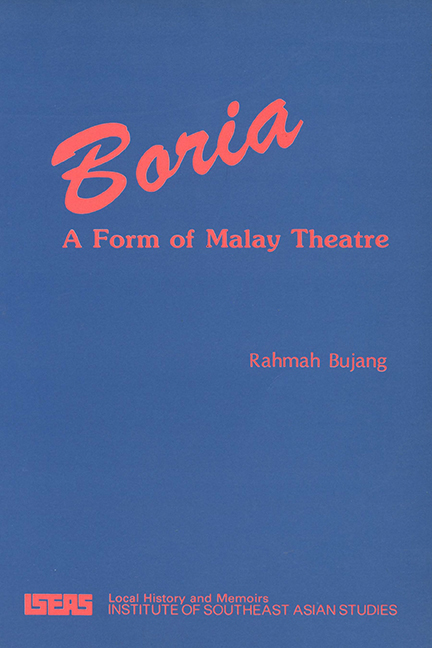5 - The Song and Dance
Published online by Cambridge University Press: 21 October 2015
Summary
Introduction
Song and dance have been a necessary element in communal type traditional and popular drama performances (Brandon 1967, p. 125; Awashti 1974, pp. 180-4). In boria they are certainly an integral part of the show. The song and dance element complements the sketch and completes the symbolic action of the whole. Since the introduction of the form into Penang, boria has always involved singing and dancing. In the early days of boria, however, the song and dance were highly individualized and each performer was allowed his own version. According to veteran of the art, Pak Nyak, the individual dancers were ascribed their own medley of steps in accordance with their role. Thus, for example, one would find a performer in Arab attire doing an Arabian dance step, a soldier imitating drill and a Chinese towkay (proprietor) mimicking real persons of the time. Since World War II the sequence has taken on a whole new form of ordered rythmic movement of body and arms with measured and repetitive dance steps by the “sailors”.
Today the tukang karang leads the sequence with his com- position on the sketch's main theme or themes. He sings the verse and the “sailors” provide the chorus at the end of each stanza. The chorus here is the first verse of the song, which states in essence the aim of the song sequence, for example, the first verse and chorus of Kisah Nombor Ekor [Gambling on Numbers] is:
Many a person has been had
By the follies of gambling,
The result is always unfortunate
Ria Seni Pesaka offers objective criticism.
The song and the dance keep time with the rhythm of the musical accompaniment. The regularity of the song pattern (four-line stanza) with about fourteen to twenty stanzas and the liveliness of the synchronized dance steps give the sequence a high regularity of movement. The three elements of music, song and dance work together to create a simultaneous unity to this part of the show.
- Type
- Chapter
- Information
- BoriaA Form of Malay Theatre, pp. 69 - 81Publisher: ISEAS–Yusof Ishak InstitutePrint publication year: 1987



